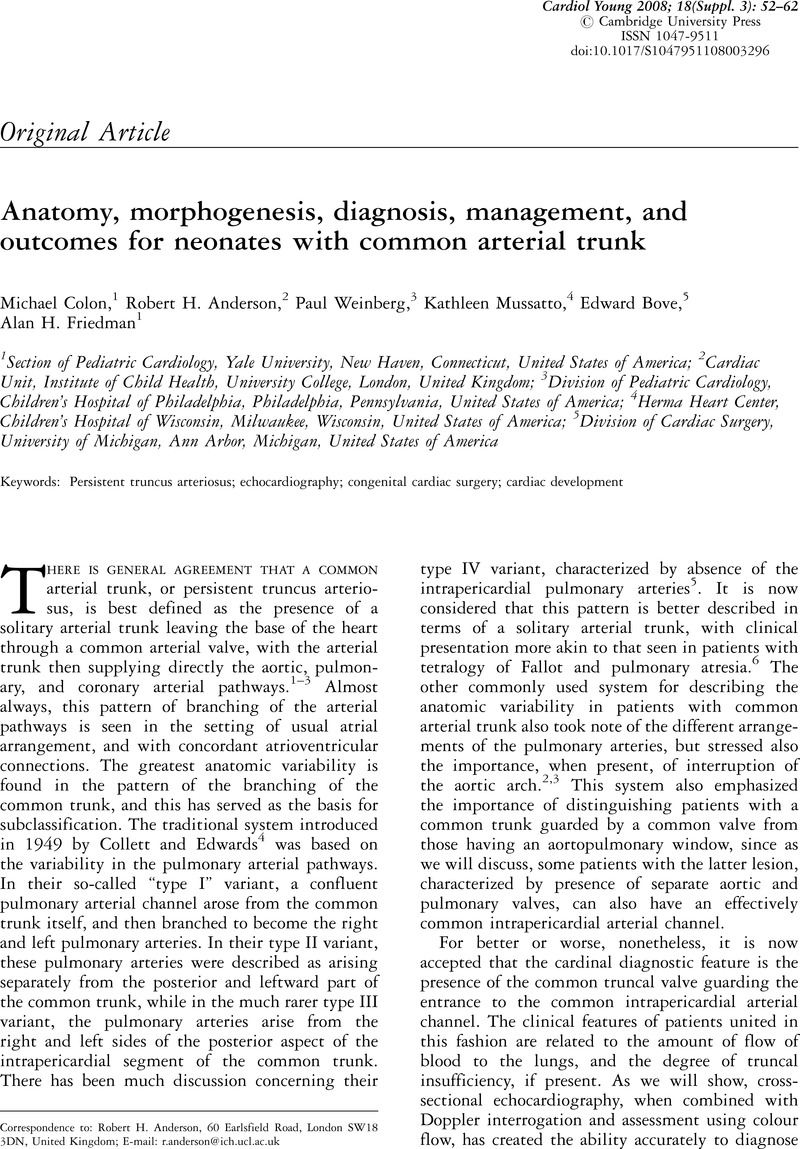Crossref Citations
This article has been cited by the following publications. This list is generated based on data provided by Crossref.
Hawkins, John A.
Kaza, Aditya K.
Burch, Phillip T.
Lambert, Linda M.
Holubkov, Richard
and
Witte, Madolin K.
2010.
Simple Versus Complex Truncus Arteriosus.
World Journal for Pediatric and Congenital Heart Surgery,
Vol. 1,
Issue. 3,
p.
285.
Koleśnik, Adam
and
Niszczota, Cezary Sebastian
2012.
Morfologia kliniczna wad drogi odpływu.
Pediatria Polska,
Vol. 87,
Issue. 5,
p.
498.
Perloff, Joseph K.
and
Marelli, Ariane J.
2012.
Clinical Recognition of Congenital Heart Disease.
p.
492.
Nakamura, Yuki
Aoki, Mitsuru
Hagino, Ikuo
Koshiyama, Hiroshi
Fujiwara, Tadashi
and
Nakajima, Hiromichi
2014.
Case of Congenital Aneurysm of Sinus of Valsalva With Common Arterial Trunk.
The Annals of Thoracic Surgery,
Vol. 97,
Issue. 2,
p.
710.
Bibevski, Steve
Friedland-Little, Joshua
Ohye, Richard G.
Thor, Thorsson
and
Gaies, Michael G.
2014.
Pediatric and Congenital Cardiology, Cardiac Surgery and Intensive Care.
p.
1983.
Scansen, Brian A.
Schneider, Matthias
and
Bonagura, John D.
2015.
Sequential segmental classification of feline congenital heart disease.
Journal of Veterinary Cardiology,
Vol. 17,
Issue. ,
p.
S10.
2016.
ASE's Comprehensive Echocardiography.
p.
701.
Hofbeck, Michael
Deeg, Karl-Heinz
and
Rupprecht, Thomas
2017.
Doppler Echocardiography in Infancy and Childhood.
p.
167.
Jaggers, James
and
Cole, Charles R.
2019.
Critical Heart Disease in Infants and Children.
p.
661.
Hazekamp, Mark G
Barron, David J
Dangel, Joanna
Homfray, Tessa
Jongbloed, Monique R M
Voges, Inga
Anderson, Robert H
Belli, Emre
Bellsham-Revell, Hannah Rosemary
Herberg, Ulrike
Photiadis, Joachim O M
Stoica, Serban C
and
d’Udekem, Yves
2021.
Consensus document on optimal management of patients with common arterial trunk.
European Journal of Cardio-Thoracic Surgery,
Vol. 60,
Issue. 1,
p.
7.
Adamson, Gregory T.
Houyel, Lucile
McElhinney, Doff B.
Maskatia, Shiraz A.
Ma, Michael
Hanley, Frank L.
and
Lopez, Leo
2021.
Unilateral Branch Pulmonary Artery Origin From a Solitary Arterial Trunk With Major Aortopulmonary Collaterals to the Contralateral Lung: Anatomic and Developmental Considerations.
Seminars in Thoracic and Cardiovascular Surgery,
Vol. 33,
Issue. 3,
p.
780.
Hazekamp, Mark G.
Barron, David J.
Dangel, Joanna
Homfray, Tessa
Jongbloed, Monique R.M.
and
Voges, Inga
2021.
Consensus document on optimal management of patients with common arterial trunk.
Cardiology in the Young,
Vol. 31,
Issue. 6,
p.
915.
Naimo, Phillip S.
and
Konstantinov, Igor E.
2021.
Surgery for Truncus Arteriosus: Contemporary Practice.
The Annals of Thoracic Surgery,
Vol. 111,
Issue. 5,
p.
1442.
Bibevski, Steve
Friedland-Little, Joshua
Gaies, Michael
and
Ohye, Richard G.
2021.
Pediatric and Congenital Cardiology, Cardiac Surgery and Intensive Care.
p.
1.
Mavroudis, Constantine
Backer, Carl L.
Brown, John W.
and
Williams, William G.
2023.
The Congenital Heart Surgeons' Society Presidents and Their Contributions.
World Journal for Pediatric and Congenital Heart Surgery,
Vol. 14,
Issue. 5,
p.
559.
Deal, Barbara J.
Hauck, Amanda L.
Tsao, Sabrina
Patel, Angira
Lee, Simon
and
McElhinney, Doff B.
2023.
Pediatric Cardiac Surgery.
p.
47.
Marelli, Ariane J.
and
Aboulhosn, Jamil A.
2023.
Perloff's Clinical Recognition of Congenital Heart Disease.
p.
458.
Loke, Yue-Hin
Gupta, Saurabh Kumar
Mandell, Jason
Schidlow, David
Wernovsky, Gil
and
Olivieri, Laura
2024.
Congenital Heart Disease Illustrated.
Journal of Thoracic Imaging,
Vol. 39,
Issue. 2,
p.
W19.





